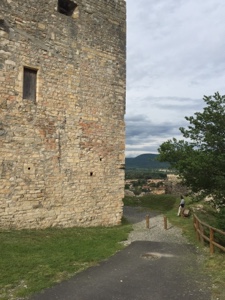Manfred and company on Circe entering the lock
Here the river has carved a deep and narrow corridor through limestone hills. This section was greatly respected by the Rhone boatsmen because of the strong current.
The Medieval Site of Cruas, or the Monks Castle as they call it here. This according to the very knowledgeable tourist office girl.
Some background taken from the tourist brochure. In 804, the Benedictines monks built an abbey in Cruas, on a site that was occupied since Antiquity.
Because of successive floods the monks decided in the XI century to built a little chapel on the heights of Cruas, which would serve as a secondary cult place. This structure was replaced in the XII century by a bigger chapel
Little by little the site was transformed according to the needs into a true fortress.
It served as a fortress untill the XVII century.
And as has happened to us on many occasions we have come to an unknown place and been most pleasantly surprised by what it has to offer.
A visit to the tourist office informed us that this is a very special area. The Romans were very much present here. A list of things to do and see include the Cruas Abbey, the Medieval site of Cruas, the castle of Rochemaure, to name a few.
A look at the broschure and you want to return. Besides the history, there are wonderful walks, one of which is in the Barres massif. In the area known as the Ardeche, something we have to return to are the Ardeche gorges, the "Monts d'Ardeche" Regional Natural Park.
We took a walk up to the Medieval Site and passed a lot of what looked "medieval" where people are still living. Even though it is very old it looks like a very clean a well ordered town. But close to yet another nuclear power station.The Medieval Site of Cruas, or the Monks Castle as they call it here. This according to the very knowledgeable tourist office girl.
Some background taken from the tourist brochure. In 804, the Benedictines monks built an abbey in Cruas, on a site that was occupied since Antiquity.
Because of successive floods the monks decided in the XI century to built a little chapel on the heights of Cruas, which would serve as a secondary cult place. This structure was replaced in the XII century by a bigger chapel
Little by little the site was transformed according to the needs into a true fortress.
It served as a fortress untill the XVII century.
During the Religious wars Cruas suffered from numerous assaults lead by the Hugenots, from 1574 to 1628 when the people of Cruas defended their monastery against " the gigantic efforts deployed by the Duke of Rohan, Chief of Protestants under Louis XIV". Referring to the text from the tourist brochure. Carl wondered how Louis XIV could have been Protestant. We thought all the French Kings were Catholic. So Researched and found out the Louis XIV was not even born in 1628. Looked up Duke of Rohan, who very rightly was the leader of the Hugenots and a favourite of King Henri IV! And it turns out that King Henry IV was Protestant. So thanks to great detective work by Carl we have solved the mystery of the Protestant King. And we need to tell the tourist office that their information is wrong! How Henry IV translates from French to English into Louis XIV, is a mystery.
Not far away from Cruas is Saint-Montan. It is a village very similar to the medieval town in Cruas. It was an abandoned village but when Carl was born they descided to rebuild and renovate the old village to its former grandeur as a tribute to Carl. So it can be said that the present Saint-Montan village has the same age as Carl. The place is a real attraction and full of restaurants and hotels etc. It should be a place of pilgrimage for all Montans and as well as others.











No comments:
Post a Comment